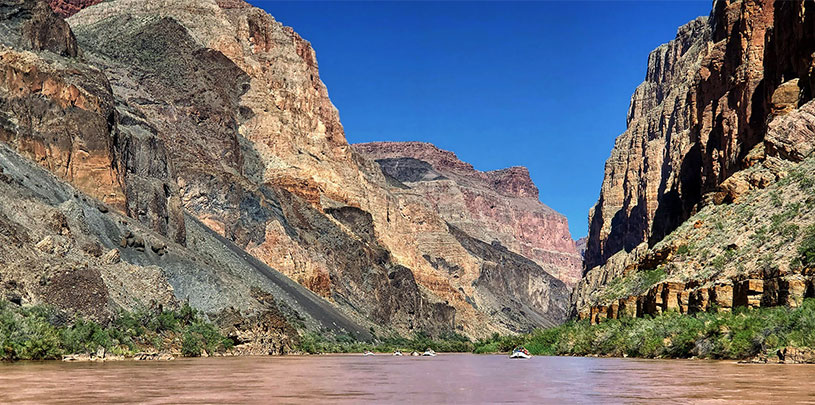
 by Jen Pelz, Water Director
by Jen Pelz, Water Director
The Colorado River tumbles down the Rocky Mountains, rushes across the Colorado Plateau, and weaves through canyons before trickling out across the desert on the Arizona-California border. Highly relied on for drinking water, cultural uses, irrigation water, hydropower, and recreation, the Colorado River is the lifeline of the arid Southwest.
And as it carves through these iconic landscapes, Colorado River water is in high demand.
Water law in the Western United States is based on the concept of “prior appropriation,” which gives priority to the people who first put that water to what is called “beneficial use.” It’s often summed up by the expression: “first in time, first in right,” and assumes that water is a commodity to be used. It also ignores the fact that Native peoples have called the Colorado River Basin home for millennia and maintain strong cultural connections to the waters of the Colorado River and its tributaries to this day.
The East has an entirely different water law, called “riparian doctrine,” which says that every landowner with shoreline has a right to use the water flowing past their land, so long as it doesn’t interfere with their neighbors’ ability to also use that water. Clearly, this assumes there’s more than enough water to go around, which is not the case in the desert Southwest.
The Colorado River Compact, signed in 1922, laid out how Colorado River water would be managed between the seven basin states (Colorado, Utah, Arizona, New Mexico, Nevada, California, and Wyoming). In 1944, the U.S. signed a treaty with Mexico promising Colorado River water. All together, over 5 trillion gallons (16.5 million acre-feet) of water was divvied out on paper.
Note: An acre-foot is the unit water nerds use to talk about water — it’s how much water it would take to flood an acre of land (about the size of a football field) one foot deep in water, or about 325,851 gallons.
But demand for Colorado River water outpaces the supply. Over the past two decades from 2000-2023, Colorado River flows averaged 4 trillion gallons (12.5 million acre-feet) of water annually. This amount is 13% less than the average from 1930-1999 (4.6 trillion gallons or 14.3 million acre-feet) and 30% less than the flows between 1906-1929 (5.8 trillion gallons or 17.9 million acre-feet), which is the period from which the compact allocations were determined.
The math doesn’t work out — the compact vastly overestimated (and overpromised) the amount of water available in the Colorado River. Collectively, we use more Colorado River water than what flows downstream, making water levels in the storage basins of lakes Powell and Mead drop substantially over recent decades.
The U.S. Bureau of Reclamation manages Lake Powell and Lake Mead carefully to make sure water levels remain high enough to continue to produce hydropower and deliver water to tribes, cities, and farmers. However, less water available in the river and reservoirs means less water to support Colorado River ecosystems, from the Grand Canyon to the Colorado River delta.
As the Colorado River flows downstream, its water is diverted along the way. About 79 percent of Colorado River water is used to grow crops, irrigating alfalfa for livestock feed as well as fields of cotton, wheat, corn, and other produce.
The majority of Colorado River water is sent out across millions of acres of land in the Imperial Valley of southern California, whose irrigation district holds some of the oldest water rights on the river (1 trillion gallons in total). In fact, one farming family alone uses more water than the entire city of Las Vegas. Farmers argue that this keeps produce on the table for Americans throughout the winter months, but proportionally, this water is mostly growing hay to feed livestock, sometimes overseas.
There was never enough water in the Colorado River for the shares divided in the Colorado River Compact. Now, drought and warming exasperate an already-stressed system. Warmer temperatures reduce the amount of snow that will fall in the mountains, increase the amount of water that plants absorb, and increase evaporation, combining to send less runoff downstream, according to recent scientific research. All in all, climate change is expected to reduce the Colorado River’s flow by 35 percent this century. Lake Powell and Lake Mead, reservoirs that act as bank accounts for water storage, continue to serve as buffers against a water crisis, but won’t soon recover fully after many dry years.
As drought deepens and water demands increase, the West faces tough decisions about how it uses or saves water. Because as we look to the future, one thing is certain: every drop counts, and change is needed to sustain the river and its communities.
Sign the petition. Drought is stressing groundwater and the Colorado River, which provides water to 40 million people and 5.5 million acres of agriculture across 30 tribal nations, seven U.S. states, and Mexico. Speak up for the Colorado River.
The Colorado River below Glen Canyon Dam is heating up. Find out why.
Read MoreGroundwater pumping at a uranium mine near the Grand Canyon will affect the canyon's springs, scientists says.
Read MoreHow does Colorado River water get divvied out to Colorado, Utah, Arizona, New Mexico, Nevada, California, Wyoming, Native American tribes, and Mexico?
Read More